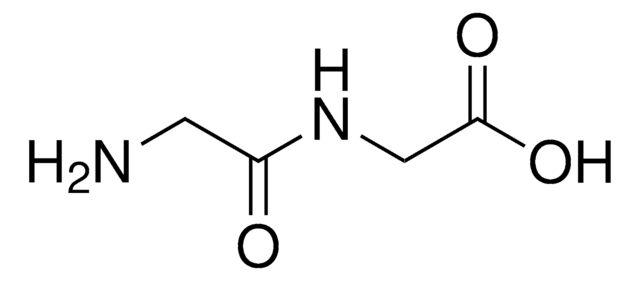G4505
Guanidine hydrochloride
≥99% (titration), organic base and chaeotropic agent
Synonym(s):
Guanidium Chloride, Aminoformamidine hydrochloride, Aminomethanamidine hydrochloride, Guanidinium chloride
About This Item
Recommended Products
biological source
synthetic (organic)
Quality Level
Assay
≥99% (titration)
form
crystalline powder
technique(s)
RNA extraction: suitable
impurities
≤0.3% water (Karl Fischer)
color
white
pH
(25 °C, 4.6 - 6 at 573 g/L)
mp
180-185 °C (lit.)
solubility
H2O: 6 M
density
1.3 g/cm3 (lit.)
absorption
≤0.10 at 260 nm in H2O at 6 M
SMILES string
Cl[H].NC(N)=N
InChI
1S/CH5N3.ClH/c2-1(3)4;/h(H5,2,3,4);1H
InChI key
PJJJBBJSCAKJQF-UHFFFAOYSA-N
Gene Information
human ... KCNA1(3736) , KCNA10(3744) , KCNA2(3737) , KCNA3(3738) , KCNA4(3739) , KCNA5(3741) , KCNA6(3742) , KCNA7(3743) , KCNB1(3745) , KCNB2(9312) , KCNC1(3746) , KCNC2(3747) , KCNC3(3748) , KCNC4(3749) , KCND1(3750) , KCND2(3751) , KCND3(3752) , KCNF1(3754) , KCNG1(3755) , KCNG2(26251) , KCNG3(170850) , KCNG4(93107) , KCNH1(3756) , KCNH2(3757) , KCNH3(23416) , KCNH4(23415) , KCNH5(27133) , KCNH6(81033) , KCNH7(90134) , KCNH8(131096) , KCNQ1(3784) , KCNQ2(3785) , KCNQ3(3786) , KCNQ4(9132) , KCNQ5(56479) , KCNS1(3787) , KCNS2(3788) , KCNS3(3790) , KCNV1(27012) , KCNV2(169522)
Looking for similar products? Visit Product Comparison Guide
General description
Application
- to perform absolute quantitation of amyloid-beta (Aß) isoforms in plasma
- in protein carbonylation assay
- for the quantification of glycosaminoglycans (GAG)
- for denaturation of cow′s milk allergens
- as a control in antiviral screening tests with coxsackievirus B3 (CVB3)
- in RNA isolation to dissociate nucleoproteins and inhibit RNase
Biochem/physiol Actions
Features and Benefits
- Suitable for Biochemical and Cell Biology research
- Ideal for RNA extraction
- High purity product for research applications
Packaging
Each kit contains 3 x 100G samples, each sample from a uniquely manufactured lot.
Caution
Preparation Note
The maximum solubility of guanidine hydrochloride in water at room temperature is approximately 6M.
Other Notes
Legal Information
also commonly purchased with this product
Signal Word
Warning
Hazard Statements
Precautionary Statements
Hazard Classifications
Acute Tox. 4 Inhalation - Acute Tox. 4 Oral - Eye Irrit. 2 - Skin Irrit. 2
Storage Class Code
11 - Combustible Solids
WGK
WGK 1
Flash Point(F)
Not applicable
Flash Point(C)
Not applicable
Personal Protective Equipment
Certificates of Analysis (COA)
Search for Certificates of Analysis (COA) by entering the products Lot/Batch Number. Lot and Batch Numbers can be found on a product’s label following the words ‘Lot’ or ‘Batch’.
Already Own This Product?
Find documentation for the products that you have recently purchased in the Document Library.
Customers Also Viewed
Our team of scientists has experience in all areas of research including Life Science, Material Science, Chemical Synthesis, Chromatography, Analytical and many others.
Contact Technical Service





